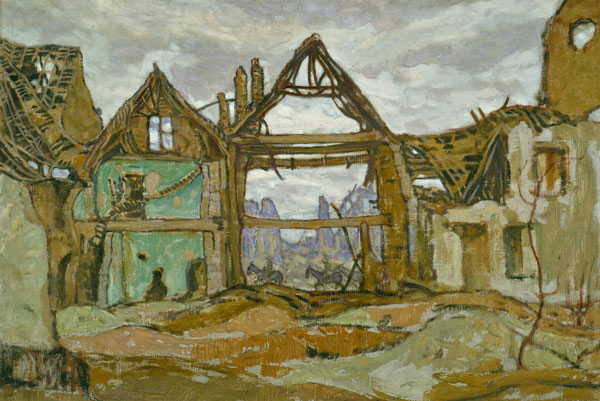It was 1916. The First World War was in full swing. And while men were dying in the trenches all around him, A.Y. Jackson was about to save his own life by painting a portrait.
This was back before Jackson was famous. In fact, none of the painters in the Group of Seven was famous yet. They weren’t even called the Group of Seven yet. So while Jackson would eventually become known as one of the greatest painters in Canadian history, he started the war as an anonymous soldier crawling through the blood-soaked mud of Flanders.
As you might imagine, it didn’t go well. Within a few months, Jackson had been seriously wounded, struck in the shoulder and the hip during a German bombardment at Ypres. While he was recovering from his injuries, he received even more bad news: his close friend, Tom Thomson, had died mysteriously in Algonquin Park. Those sad and dangerous months took a terrible toll on Jackson. When another member of the Group of Seven — Fred Varley — saw what the war had done to his friend, he was worried. “I’m sure if he had to go through the fight any more,” he wrote in a letter back home, “he would be broken.”
Things didn’t look like they were going to get better any time soon. While Jackson was away recovering, his unit was in turmoil: there was a mutiny gathering steam. And soon, they’d be back on the front lines outside Ypres, at the bloody Battle of Passchendaele, where most of them would die — along with hundreds of thousands of other men — in just a few short months.
But then suddenly, out of nowhere, Jackson was offered a way out.
It came at the best possible moment: while he was digging a latrine. An officer came to see him with a proposition. A Canadian newspaper baron turned British politician — Lord Beaverbrook — had started something called the Canadian War Records Office. The idea was to have artists document the Canadian war effort. They were looking for men who were already enlisted. And they’d heard that Jackson could paint. If he were able to land the gig, his days as a soldier in the trenches would be over.
So that’s how he ended up in a big art studio on Earls Court in London. There waiting for him, he found paint and canvas and a Canadian war hero.
Corporal John Chipman Kerr had been awarded the Victoria Cross, the highest honour for military valour you can get in what was then the British Empire. He’d had a finger blown off by a grenade during the Battle of the Somme, but refused to have his wound treated until he’d rushed the enemy lines, taken 62 prisoners and captured their trench. The Canadian War Records Office wanted a portrait of him. That was Jackson’s first assignment.
And that was a problem. Jackson was a landscape artist; he wasn’t used to painting portraits. It had been years since he even tried. At first, he tried to talk his way out of it. But it didn’t work. He would have to give it a go. “Hanging over me,” he wrote later in his autobiography, “was the prospect of being returned to the infantry if I failed in this first assignment.”
So he set down to work and painted for his life.
It got off to rough start. He kept having to give up, to scrape the canvas clean and begin all over again. It was slow work. And it probably didn’t help that Corporal Kerr — excited to be on leave — kept suggesting they play hooky and head down to the pub instead. But in end, Jackson was able to produce a half-decent portrait. Not great, they say — the legs look weird — but good enough that he didn’t get fired.
And so, thanks to not screwing up that portrait, A.Y. Jackson was able to spend the rest of his war travelling across the Western Front, painting the ravaged landscapes in his trademark Impressionist style. He lived long enough to see the end of the conflict, long enough to return home to Toronto, long enough to rejoin the group of friends who were about to change the Canadian art world forever.
A version of this post originally appeared on the The Toronto Dreams Project Historical Ephemera Blog as part of the Dreams Project’s tour tracing the history of Toronto in the UK. You can find more sources, photos, links and related stories there.
Image: cropped version of A.Y. Jackson’s “House of Ypres” via Wikimedia Commons.


